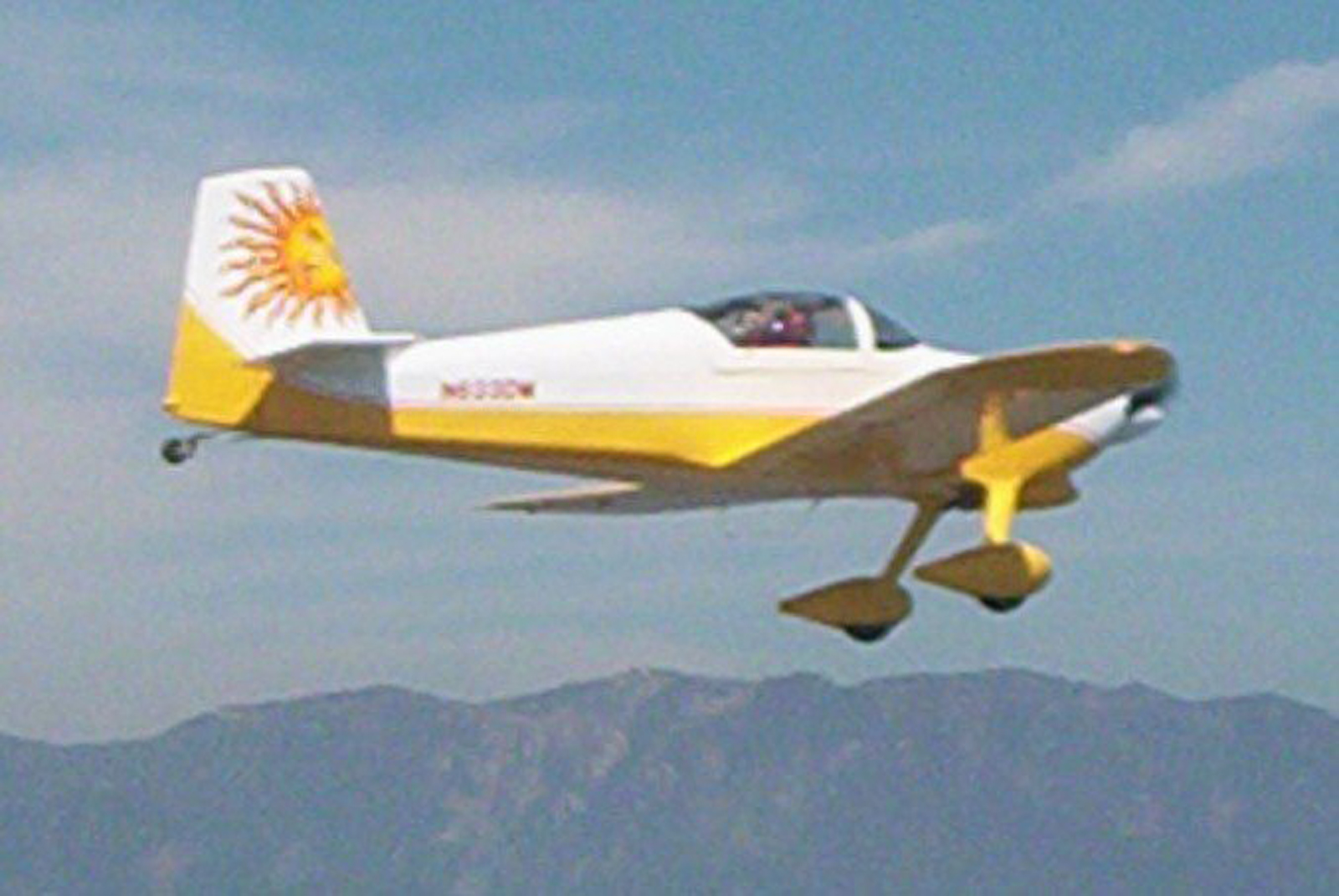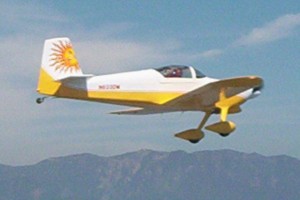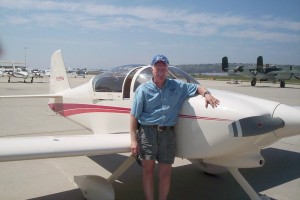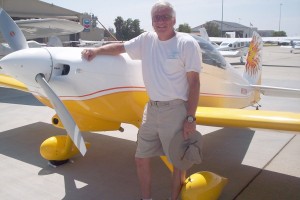By Fred “Crash” Blechman
It isn’t often that private pilots get a chance to fly in formation. But experienced pilots, in groups that know each other and respect each other’s flying skills, occasionally make such arrangements. Such was the case when I flew in one of two experimental aircraft on a prearranged formation flight.
It was press day for the recent Camarillo Air Show 2006, conducted by the local Experimental Aircraft Association chapter 723. I’d gone out early, with Lee “Stretch” Auger, my driver/photographer, to talk to some of the pilots who’d be in the air show, and to bum a ride in one of the planes.
As a member of chapter 723, I was aware that a small number of very active members did most of the work, as in most organizations. Two gentlemen, who are always evident and involved with chapter 723 activities, are Norm Hall and Don Miller. I flew with Norm in an RV-6A, as he flew in formation with Don, flying his RV-6, with Stretch aboard.
Before telling you about the unusual flight, let me first tell you about these two homebuilt experimental aircraft, and then I’ll relate some details about the pilots.
What are “homebuilt experimental aircraft?” These aircraft are built in garages or airport hangars by individuals who designed their own aircraft, or by those who bought kits or detailed plans. The aircraft carry an “experimental” classification, because the Federal Aviation Administration doesn’t certify them as production airplanes, like a Piper or Cessna. When completed, they’re properly inspected and flight tested, but still carry the “experimental” designation.
Both planes we flew that day were powered by Lycoming O-360 180-hp engines, and were built from kits provided by Van’s Aircraft. The RV-6 is a single-engine low-wing airplane, with a clear slide-back canopy, a fixed landing gear and a cabin with two side-by-side seats. Don Miller’s RV-6 has a tailwheel, while Norm Hall’s RV-6A has a rudder-steerable nosewheel. H.B. Hutchinson built this RV-6A, which won the Lincoln Award at EAA AirVenture Oshkosh 2001, the year the plane was completed.
Norm Hall was never a military pilot, yet he has accumulated about 10,000 pilot hours. He’s an instrument-rated commercial pilot, single and multi-engine, has an air transport pilot rating and is a qualified helicopter and glider pilot. He also has 36 hours in a Polish Iskra jet trainer and is building a 70 percent scale Stewart S-51—a P-51 replica.
Don Miller, a degreed aeronautical engineer, is a private pilot with power and glider ratings. His present RV-6 is the second experimental airplane he’s built. He and a partner designed and built the first in the 1970s, a single-seat, Volkswagen-powered, all-metal biplane he called Cricket. Sold in 1977, it’s still on the FAA registry. Don began building his RV-6 from a “quick-build kit” at the end of 2000, and first flew it in September 2005. He and his wife, Martha, flew it to Colorado this past summer.
After Norm and Don had preliminary discussions about where to fly, and after selecting plane-to-plane flight frequencies, we boarded our respective aircraft. With roll-back canopies, it was easy to embark. Stretch climbed into the right seat of Don’s beautifully decorated RV-6, while I entered the left seat of the RV-6A. Normally, the left seat is for the pilot in command, but in this aircraft, the original builder provided all the main flight, navigation and engine instruments for the command pilot’s use from the right seat.

This RV-6A had all the critical engine and navigation instruments arranged for the pilot in the right seat.
Norm entered the right seat and helped me figure out the quick-release, five-way seat and shoulder belt arrangement. I couldn’t be more impressed with the clean design of the instrument panel, the fine upholstery, the comfortable seat and the excellent visibility from the cockpit. All the flight controls were readily accessible, and I could easily see the flight control instruments to my right.
The plan was to taxi out with Don going first, check the engines and take off one right after the other, joining up as we climbed. It would’ve been simple, except that just as Don took off, several planes called for landing clearance, and the tower held us on the ground for about five minutes. As we waited on the approach to the runway, Don’s airplane disappeared in the haze.
When Norm finally got clearance, we took off from Runway 26, airborne at 70 miles per hour, with 2,600 rpm and 29 inches of manifold pressure. We climbed at 2,000 feet per minute at 110 miles per hour and leveled off at 2,500 feet, cruising at 160 mph, 2,300 rpm and 23 inches of manifold pressure.
Haze was up to about 3,000 feet, limiting visibility to about five miles, so we couldn’t see Don’s aircraft. As we headed toward the Pacific Ocean, I took the controls while Norm switched to the plane-to-plane frequency, to establish a rendezvous location. We decided to meet somewhere near the Ventura Fairgrounds, along the coast.
Cruising along, I was impressed with the RV-6A’s ease of control and the outstanding visibility from this little fighter-like aircraft with its “bubble” canopy. I did some banking, and found the controls responsive, needing very little rudder to stay in balanced flight.
Finally, we spotted Don’s plane at the two o’clock position, flying a straight course that would cross below us at a 45-degree angle heading left. Ideally, if he’d been in a left turn, it would’ve been easy to rendezvous, but Don was flying straight. I dropped the nose and made a sharp left turn to match his flight path and altitude. We slowly caught up with Don’s RV-6 and Norm took the controls as we moved to his right side.
By now, we were over the Pacific Coast, headed toward Santa Barbara. We continued until we spotted Santa Barbara Airport, then we turned around. Don took off on his own, and I took the controls and flew us back, at 2,500 feet, banking as necessary to closely follow the rugged coastline to the Ventura Fairgrounds. I took a heading for Camarillo Airport, passing south of Santa Paula Airport, where Don rejoined us and took the lead.
We intended to make a two-plane “fighter” break over the Camarillo Airport runway, and Norm took over for the planned close formation, break and landing—but the tower had too much traffic, and wouldn’t give us permission for a formation flyover or break. Norm took an interval on Don, and came in on a long straightaway to a smooth landing, as Don turned off ahead of us onto the taxiway. Another fun flight!
Chapter 723 holds morning meetings at its airport hangars the second Saturday of each month. Everyone is welcome. For information, visit [http://www.eaa723.org].














